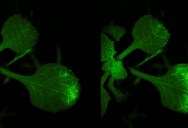Researchers Have Finally Recorded Plants “Talking” On Camera And Warning Each Other About Attacking Insects
We have known for some time that plants are more “aware” than we previously realized – or at least, that they have capabilities that go beyond what one might assume a plant to have.
Now, this video showing two of them “communicating” points to an even greater depth of understanding.
Plants are surrounded by a fine mist of airborne compounds that they use as a form of communication – mostly to warn other plants of predators and other threats.
The “smell” they put off can keep hungry herbivores from feeding while also warning neighboring plants that they need to do the same.

Scientists have been cataloguing species that employ this method – around 80 so far – since the 1980s.
Now, a team of researchers in Japan are using video to reveal how exactly plants receive and respond to these alarms raised by their close neighbors.
Molecular biologists Yuri Aratani and Takuya Uemura created a pump to transfer compounds sent by injured plants suffering attacks by insects to their still-whole neighbors.
The plants had been genetically altered to shine bright green when they detected an influx of calcium ions – which is also a way that human brain cells communicate.
A fluorescence microscope was on hand to catch the hot gossip as it flew by.
They used two tomato plants and set caterpillars loose on the the first. They released their volatile compounds and the researchers concentrated them in a plastic bottle, pumping them onto the second plants at a consistent rate.

Not exactly natural, but researchers wanted to be able to analyze exactly what compounds were released. They found two compounds – Z-3-HAL and E-2-HAL, both of which induced calcium signals.
The undamaged plants responded with a burst of calcium signals that rippled across their leaves.
The cells that first responded to the danger were guard, mesophyll, or epidermal cells.

Guard cells are bean-shaped and form small pores that open up to the atmosphere when plants take in CO2. Mesophyll cells are the inner leaf tissue, and the epidermal cells are the outermost layer.
When the second plants were exposed t Z-3-HAL, their guard cells generated calcium signals within a minute, and the mesophyll cells got the message not long after that.
“We have finally unveiled the intricate story of when, where, and how plants respond to airborne ‘warning messages’ from their threatened neighbors. This ethereal communication network, hidden from our view, plays a pivotal role in safeguarding neighboring plants from imminent threats in a timely manner.”
It’s pretty amazing when you think about it.
And even more mind-blowing that we’re able to actually see it, too.
Thought that was fascinating? Here’s another story you might like: Why You’ll Never See A Great White Shark In An Aquarium

Sign up to get our BEST stories of the week straight to your inbox.




